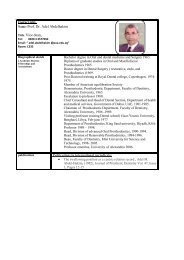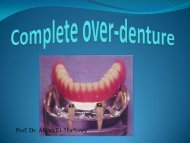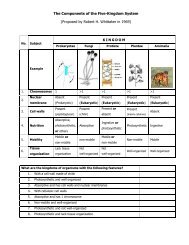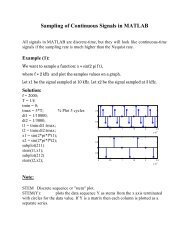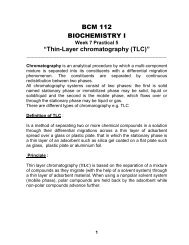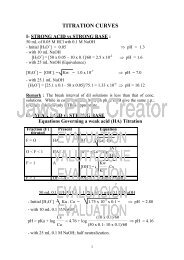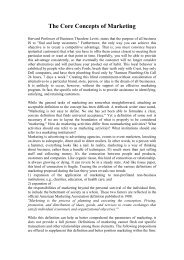Unorganised Drugs
Unorganised Drugs
Unorganised Drugs
You also want an ePaper? Increase the reach of your titles
YUMPU automatically turns print PDFs into web optimized ePapers that Google loves.
PHR 243<br />
PHARMACOGNOSY & MEDICINAL PLANTS (II)<br />
<strong>Unorganised</strong> <strong>Drugs</strong><br />
<strong>Unorganised</strong> drugs are materials having a structre that is<br />
fairly uniform throughout and are not composed of cells.<br />
They are usally derived from prats of plants of animals by<br />
some process of extraction, such as incision e.g., opium,<br />
decoction e.g., agar, expression e.g., olive oil, or natural<br />
secretions such as beeswax and myrrh.<br />
<strong>Unorganised</strong> drugs are frequently solids, but such as oils<br />
and balsams, are fluids. In their description, the morphological<br />
terms are not applied and therefore the physical characters of<br />
forms are used as, color, odor, fracture, solubilities in common<br />
organic solvents and chemical tests, all of which are used in<br />
their identification.<br />
Unorganized drugs may be classified under headings<br />
based upon their origin and nature, giving well characterized<br />
groups, such as:<br />
a) Latex e.g., opium<br />
b) Dried juice e.g., Aloes<br />
c) Extracts e.g., catechu<br />
d) Saccharine substances e.g., Honey<br />
e) Oil and fats e.g., castor oil and lard<br />
f) Gums e.g., gum Acacia<br />
g) Resins e.g., colophony<br />
h) Waxes e.g., beeswax<br />
i) Volatile oils e.g., cinnamon oil<br />
195
RESINS<br />
Theses are natural or induced solid or semi- solid<br />
exudations from plants or from insects feeding on plants. They<br />
are characterised by being insoluble in water, mostly soluble in<br />
alcohol or ether, often uncrystallisable, and softening or melting<br />
at moderate heat forming sticky or adhesive fluid without<br />
volatilization or decomposition. They range in specific gravity<br />
from 0.9 to 1.25.<br />
Ingnited in the air, they burn with a smoky flame, owing to the<br />
high carbon content in their molecule. They are usually the<br />
oxidized terpenes of the volatile oils of plants and owing to their<br />
insolubility in water, have little taste.<br />
Resins, when pure are usually transparent, when they<br />
contain water, they are opaque, and and no longer hard and<br />
brittle. They are non- conductors of electricity, but when rubbed<br />
they become negatively electrified.<br />
A clear distinction must be made between natural resins<br />
and prepared resins. A natural resin is one which occur as an<br />
exudation e.g. mastic. A prepared resin may be made by<br />
extraction of the drug with alcohol, pouring the concentrated<br />
alcoholic percolate into an excess of acidified water, collecting,<br />
washing and drying the precipitate e.g. podophyllum and jalap<br />
resin. A prepared resin may also be derived from a natural<br />
oleoresin by driving off the volatile oil by steam distillation e.g.<br />
colophony.<br />
Careful distinction must be made between the above<br />
classes of resins and the so called synthetic resins. The latter are<br />
polymeric substances which are readily formed either by<br />
196
condensation or by addition of readily available common<br />
chemicals. For example, phenol and formaldehyde interact<br />
initially to produce o- and p- hydroxyl benzyl alcohols which<br />
then condenseto yield a large series of phenol- formaldehyde<br />
(Bakelite) resins.<br />
Resin combination :<br />
A – Oleoresins<br />
Natural oleoresins are mixtures of volatile oils and resins<br />
and therefore they are liquids or semi liquids substances<br />
depending on the amount of the volatile present. Turpentine,<br />
copaiba and canada balsam are examples of this group.<br />
B- Gum – Resins<br />
These are natural mixtures of gum and resin, usually<br />
obtained as exudations from plants, as myrrh.<br />
C- Oleo-gum- resin<br />
Resin may occur in combination with volatile oil and gum<br />
for example asafetida.<br />
D- Glycoresins<br />
Resin may be combined in a glycosidal way with sugars as<br />
the resin of the convolvulaceae being called glycoresins which<br />
are found in Ipomea, Jalap and podophylum.<br />
E- Balsams<br />
Are resinous substances that contain the aromatic balsamic<br />
acids i.e. benzoic acid or cinnamic acid or both or esters of these<br />
acide. Balsams usually contain small amount of volatile oil.<br />
197
A- RESINS<br />
1- Colophony ةينوفلقلا<br />
Colophony, (Resina colophonium Gallicum) is the residue<br />
left after steam distillation of the volatile oil from the oleoresin<br />
abtained from Pinus palustris and other species of pinus, family<br />
pinaceae<br />
Description<br />
Colophony accurs in large compact, angular, brittle, glassy<br />
pale amber to brownish- yellow masses, frequently covered with<br />
a yellow powder, transparent in thin fragments, fracture glassy;<br />
easily pulverisable to pale, almost white powder. It has faintly<br />
terebinthinate odour and taste. Colophony is insoluble in water,<br />
but soluble in alcohol, in chloroform, in ether, in benzene, in<br />
carbon disulphide, in glacial acetic acid, in fixed and volatile<br />
oils and in dilute solutions of sodium or potassium hydroxides.<br />
It is partly soluble in light petroleum. Colophony is readily<br />
fusible and burns with a heavy yellow smoke.<br />
Constituents:<br />
Colophony contains about 93% abietic acid; before<br />
distillation the resin contains large amounts of d- and l- pimaric<br />
acids. During distillation the d- pimaric acid is stable but the l-<br />
from undergoes isomeric change in to abietic acid.<br />
Test for identity:<br />
1- to about 10 ml of a 1% solution of colophony in acetic<br />
anhydride, add 1 drop of sulphuric acid; a bright purplish-<br />
red color is produced, which rapidly change to violet.<br />
2- Shake about 0.05gm of freshly powdered colophony with<br />
5 ml of light petroleum, for few minutes and filter. Shake<br />
the filterate with an equal volume of dilute copper acetate<br />
198
solution; the light petroleum layer assumes a bright<br />
bluish- green color.<br />
Uses<br />
Colophony is used in pharmacy for the preparation of zinc<br />
oxide and other adhesive plasters and ointments. Large<br />
quantities of the darker grades are destructively distilled to yield<br />
rosin spirit and rosin oil. The medium grades are largely used<br />
for the manufacture of soap and the lighter grades for sealing<br />
wax.<br />
2- Guaiacum Resin – Resina Guaiaci<br />
Plant Source: guaiacum resin is obtained from the heart wood<br />
of Guaiacum officinale and Guaiacum sanctum, family<br />
Zygophyllaceae.<br />
Preparation of the resin ;<br />
Gyaiacum wood chips are boiled in salt solution, when the resin<br />
which melts at about 85°c may be more or less separated from<br />
the wood.<br />
Description:<br />
Guaiacum resin occurs in large blocks or rounded tears<br />
about 2-3 cm in diameter, often covered with a dull green<br />
powder. The powder is grayish but become green on exposure<br />
to light and air. The taste is slightly acrid and the odor is<br />
aromatic especially when warmed.<br />
Guaiacum resin is soluble in ether, chloroform, alcohol,<br />
solutions of caustic alkalies and in chloral hydrate.<br />
199
Constituents:<br />
Some of the main resinous constituents belong to the<br />
group of lignans. These are phenolic compounds having a C18<br />
structure formed from C6-C3 units. Guaiaretic acid,which forms<br />
about 10% of guaiacum resin, is a diaryl butane. The resin<br />
contains about 70% α- and β guaiaconic acid and guaiacic acid.<br />
α - guaiaconic acid is the substance which yields the blue<br />
compound guaiac- blue when guaiacum resin is acted upon by<br />
oxidizing agents.<br />
Test for identity:<br />
Dissolve about 0.05 gm of freshly powdered resin in 5 ml<br />
of alcohol and add 1ml. of a solution of ferric chloride in water.<br />
A deep blue color is produced.<br />
Uses<br />
For use as a reagent the resin extracted form wood by<br />
means of chloroform is said to be the most sensitive. An<br />
alcoholic solution is used for the detection of blood stains,<br />
cyanogenetic glycosides, oxidase and peroxidase enzymes. See<br />
guaiacum wood.<br />
3- Mastic ةكتــــــسملا<br />
Mastic is a resin, containing little oil, obtained from<br />
cultivated variety of Pistacia lentiscus Var. chia, family<br />
Anacardiaceae<br />
Collection and preparation:<br />
The base of the shrub is cleared of weed. Flatten and<br />
covered with a special white soil to receive some of the flow.<br />
The stem and larger branches are then wounded by means of<br />
special knife which makes an incision about 2cm long and 3mm<br />
deep. Each plant is tapped repeatedly for about 5 or 6 weeks<br />
receiving in all about 200-300 wounds. A special tool is used<br />
200
for the removing the tears which harden on the plant and the flat<br />
plates of mastic which collected on the ground .<br />
Description :<br />
Mastic occurs in yellow or greenish – yellow rounded or<br />
pear-shaped tears about 3 mm in diameter. The tears are brittle<br />
but becomes plastic when chewed. Odor is slightly balsamic, the<br />
taste is mildly terebinthinate.<br />
Constituent:<br />
Mastic is an acid resin and contains triterpenoid acids such<br />
as masticadienonic acid and triterpene alcohols, about 2% of<br />
volatile oil is also present.<br />
Uses:<br />
Used in formerly official aloe and mastic pills to modify<br />
the therapeutic action of the aloe. In dentistry it is employed to<br />
form a varnish, preparation of compound mastic paint. Mastic is<br />
also used as flavoring agent.<br />
201
B-Oleoresin<br />
Copaiba,Oleoresina Copaiba<br />
Copaiba is an oleoresin obtained by incision from trunks<br />
of Copaifera Langsdorfii, family Leguminoasae, Copaiba is<br />
sometimes commercially wrongly known as Copaiba balsam .<br />
Description :<br />
Copaiba is a pale yellow, or golden brown, more or less viscous<br />
liquid, more or less transparent with occasional slight greenish<br />
fluorescence. The odor is characteristic and aromatic and taste<br />
somewhat bitter, acrid and persistent.<br />
Copaiba is insoluble in water, and is partially soluble in alcohol,<br />
chloroform, ether, benzene, acetone, carbon disulphide and in<br />
fixed and volatile oils.<br />
Constituent:<br />
Copaiba contains at least 24 sesquiterpene hydrocarbons, resin<br />
acids e.g., capaivic acid, small quantity of a bitter principle and<br />
a fluorescent substance.<br />
Uses<br />
Copaiba is chiefly employed in inflammatory affections of<br />
bladder, urethra and occasionally in chronic bronchitis .<br />
2- Male fern oleoresin. Oleoresina Filicis Malis<br />
Male Fern oleoresin may be prepared by extraction the powder<br />
rhizome, formed bases and apical buds of Dryopteris filix-mass<br />
family poly podiaceae , with ether. The ethereal extract is<br />
evaporated on a water bath until an oleoresinous extract<br />
remains.<br />
202
Description :<br />
Male Ferm Oleoresin is a thick dark green liquid, frequently<br />
depositing a granular crystalline sulstance. It has an agreeable<br />
odor and bitter astringent taste. I is insoluble in water, but<br />
soluble in ether and not less than 85% of it is soluble in light<br />
petroleum.<br />
Plate 130<br />
203
Constituents :<br />
The active constituent of male Fern are phloroglucinol<br />
derivatives which occur as mon, di, tri, and tetracyclic<br />
compounds. This constituent are acid in nature and termed<br />
filmarone and to which the Taenicide activity of the drug is<br />
due. Filicic, aspidinol, flavaspidic acid, flavaspidinol are also<br />
contained in it. Filmarone occurs as a bright yellowish-brown<br />
powder insoluble in water, soluble, in organic solvent, and<br />
alkali hydroxides and carbonate. It is slowly hydrolysed in the<br />
drug or in solution:<br />
Filmarone → Filicic acid + Aspidinol<br />
∆<br />
↓<br />
Filicin<br />
Filicic acid is therapeutically inert and upon heating , it is<br />
converted to its lactone filicin<br />
Test for identification :<br />
Mix about 0.1 gm of male Fern oleorpsin and 0.2 gm of talc.<br />
Shake vigorously with 10 ml of hot alcohol then filter. Add to 1<br />
ml of the filterate 9 ml of alcohol and 1 drop of ferric chloride<br />
solution a ligh green color is produced which changes to brown.<br />
Uses:<br />
Male Fern oleoresin is used as taenicide.<br />
204
C- Oleo-Gum Resin<br />
Asafaetida, Gummiresina Asafaetida تـــيتنحلا<br />
Source :<br />
Asafetida is an oleo-gun-resin obtained by incision from the<br />
living rhizome and root of Ferula feotida, Family Umbelliferae.<br />
The drug is collected in Iran and Afghanistan.<br />
Collection and preparation :<br />
This involves the removal of the stem and cutting of successive<br />
slices from the vertical rootstock. After each slice is removed<br />
oleogumresin exudes and when sufficiently hardened is<br />
collected and packed in tin-lined cases.<br />
Description :<br />
The drug occurs in rounded or flattened tears, from 1.2 to 2.5<br />
cm s in diameter, or as masses of these tears formed by<br />
agglomeration. They are grayish – white to dull yellow. The<br />
freshly exposed surface is yellow and translucent or milk-white<br />
and opaque, gradually passes through a very characteristics<br />
change of color on exposure to the air or light, and finally<br />
reddish brown. The odor is strong and alliaceous persistent and<br />
the taste is bitter alliaceous and acrid.<br />
Constituent<br />
Asafetida consists of volatile oil (10-16%), resin (40-60%), gum<br />
(20-30 %) and impurities. The volatile oil consisting principally<br />
of organic sulfides and pinenes. The resin consisting of<br />
asaresinotannol free and partly combined with ferulic acid.<br />
There is also some free ferulic acid. The drug contains no free<br />
205
umbelliferone. On boiling it, however with hydrochloric acid<br />
and filtering into ammonia a blue fluorescence is produced<br />
owing to the formation of umbelliferone. Ferulic acid is closely<br />
related to umbellic acid and umbelliferone<br />
Tests for identity:<br />
1- Place a drop of sulphuric acid on the freshly fractured<br />
surface of a tear, a bright red or reddish-brown color is<br />
produced changing to violet when the acid is washed off<br />
with water<br />
2- Boil 0.5 gm of coarsely powdered drug for few minutes<br />
with 5 ml HCL mixed with 5 ml of water. Filter, cool and<br />
add to the filtrate an equal volume of alcohol and excess<br />
of ammonia, a blue fluorescence is produced.<br />
Uses:<br />
A safetida is now little used in human medicine (as a<br />
carminative, expectorant and antispasmodic) although still<br />
employed incertain food spices<br />
2- Myrrh Gummiresina Myrrha رــــــــــمـلا<br />
Myrrh is an oleo – gum resin obtained from the stems and<br />
branches of Commiphora molmol, family Burseraceae.<br />
Description<br />
Myrrh occurs in tears, rounded or irregular or in masses of tears<br />
varying much in size and shape. The surface is usually covered<br />
with a fine yellowish-brown powder. Beneath this the color is<br />
reddish-brown or reddish-yellow. The fracture is brittle and<br />
uneven.<br />
206
Constituents:<br />
Myrrh contains 7-17% of volatile oil, 25-40% of resin, 57-61 %<br />
of gum and 3-4 % of impurities. The volatile oil contains<br />
terpenes, sesquiterpenes, esters, cuminic aldehyde and eugenol.<br />
The gum present in the drug is similar to acacia gum and<br />
contain also an oxidase enzyme.<br />
Test for identity :<br />
Triturate about 0.5 gm of myrrh with 1 gm of sand and shake<br />
with 10 ml of ether. Filter, divide the filtrate into two portions<br />
and evaporate in a porcelain dish. To the film left in one<br />
porcelain dish, add few drops of nitric acid; a purplish-violet<br />
color is produced. Over the film left in the other porcelain dish<br />
pass the vapour of bromine, where a violet color is produced.<br />
Uses :<br />
Myrrh has stimulant and antiseptic properties, it used as a mouth<br />
wash and us uterine stimulant and emmenagogue.<br />
D – Balsams<br />
1- Benzoin ىواجلا<br />
Benzoin is a balsamic resin obtained from the incised stem<br />
of Styrax benzoin known in commerce as Sumatra benzoin<br />
Or Styrax tonkinensis , known in commerce as Siam benzoin<br />
family Styraceae. The trees from which benzoin is obtained do<br />
not contain any special secreting cells or ducts and normally<br />
produce no benzoin, the formation of which is induced by injury<br />
to the tree.<br />
DESCRIPTION<br />
Sumatra benzoin occurs in masses consisting of opaque creamy<br />
white tears embedded in a dull grayish-brown or sometimes<br />
reddish-brown matrix. It is in hard and brittle and the fractured<br />
207
surface is dull and uneven. It possesses an agreeable balsamic<br />
odor and slightly acrid taste, when gradually heated it melts and<br />
evolves whitish irritating fumes of benzoic and cinnamic acids,<br />
when a little of the crushed resin is warmed with dilute<br />
sulphuric acid and potassium permanganate, benzaldehyde is<br />
evolved indication the presence of cinnamic acid in the drug.<br />
Siam benzoin occurs in tears or in blocks the tears are of<br />
variable size they are yellowish brown or reddish brown or<br />
reddish brown externally but milky white and opaque internally,<br />
the block form consists of small tears embedded in a somewhat<br />
glassy, reddish-brown, resinous matrix. It has vanillin like odour<br />
and balsamic taste.<br />
CONSTITUENTS<br />
Sumatra benzoin contains free balsamic acid (cinnamic<br />
and benzoic acid) and esters derived form them also present are<br />
triterpenoid acids. The content of total balsamic acids is at least<br />
25% and the amount of cinnamic acid is usually double that of<br />
benzoic acid. Up to 20% of free acids may be present the drug<br />
contains, in addition traces of benzaldehyde, vanillin, phenyl<br />
propyl cinnamate, styrol and styracin.<br />
Siambenzoin consist chiefly of coniferyl benzoate, other<br />
constituents are free benzoic acid, triterpenoid acids and<br />
vanillin.<br />
TESTS FOR IDENTITY:<br />
1- when about 0.5 gm of powdered benzoin is warmed with<br />
10ml of potassium permanganate solution, a faint odor of<br />
benzaldehyde is developed only with Sumatra benzoin but<br />
not with the Siam benzoin.<br />
2- Digest about 0.2gm of the coarsely powdered benzoin<br />
with 5ml of ether for about 5 minutes decant about 1ml of<br />
208
the ethereal solution into a porcelain dish containing 2-3<br />
drops of sulphuric acid and mix carefully, a deep purplish<br />
– red color with siam benzoin and deep reddish brown<br />
color in produced with Sumatra benzoin.<br />
Uses:<br />
Benzoin when taken internally acts as an expectorant and<br />
antiseptic, externally it is stimulant and antiseptic.<br />
2- Balsam of Tolu ولوطلا مسلب<br />
Balsamum tolutanum<br />
Balsam of tolu is balsam obtained by making incisions in trunk<br />
of Myroxylon balsamum, Family Leguminosae.<br />
Description:<br />
Balsam of Tolu when freshly imported is a soft yellowish -<br />
brown semi – solid, resinous mass which takes the form of the<br />
vessel in which it is kept, on keeping it gradually hardens to<br />
brownish and especially in cold weather brittle and easily<br />
powdered, readily soften when warmed, it has an agreeable<br />
fragrant odor which is not powerful and an acidulous balsamic<br />
taste and adhere to the teeth when chewed. It is easily soluble in<br />
alcohol, acetone, and chloroform.<br />
Constituent:<br />
Tolu balsam contains about 7.5 % of an oily liquid consisting<br />
of benzyl benzoate with little benzyl cinnamate, traces of<br />
vanillin, free aromatic acids, principally cinnamic (12-15%)<br />
and benzoic acid (8%).<br />
The resin forming about 80% of the drug, yields by<br />
saponification the alcohol toluresinotannol, cinnamic acid<br />
and little benzoic acids.<br />
209
Test for identity<br />
1- A solution of balsam tolu im alcohol is acid to litmus<br />
paper<br />
2- To an alcoholic solution of the balsam (5%) add a few<br />
drops of ferric chloride a green color produced<br />
3- Boil 1gm of balsam of tolu with 5ml of water filter add to<br />
the filtrate 3ml of potassium permanganate and warm the<br />
odor of benzaldehyde is developed.<br />
Use:<br />
Tolu balsam in used chiefly as a pleasant ingredient in<br />
cough mixtures it possesses antiseptic properties due to cinnanic<br />
and benzoic contained in it .<br />
3-Balsam of Peru, Balsamum peruvianum<br />
وريب مسلب<br />
Balsam of Peru is a balsam exuded from the trunk of<br />
Myroxylon pereirae, family Leguminosae, after the trunk has<br />
been beaten and scorched.<br />
DESCRIPTION<br />
Balsam of peru is a rather viscid oily liquid, free from<br />
stickiness and stringiness.<br />
It appears black in bulk, but in thin layers it is dark reddish –<br />
brown and transparent. It has a fragrant balsamic odour,<br />
somewhat vanilla – like odor and acrid slightly bitter taste.<br />
The drug is almost insoluble in water. It is soluble in equal<br />
volume of alcohol. The specific gravity, 1.1470-1.170 is a<br />
good indication of purity.<br />
210
Constituents:<br />
Balsam of peru consists mainly of an oily fluid portion<br />
mixed with dark resin. The fluid potion (cinnamein) constitutes<br />
from 56-90% of the drug and consists of benzylbenzozte and<br />
benzyl cinnamate. It also contains about 28% of resin consisting<br />
of peruresinotannolcombined with cinnamic and benzoic acids,<br />
small quantities of vanillin and free cinnamic acid.<br />
Test For Identity<br />
Shake about 0.5 gm of balsam Peru with 10 ml of water<br />
,the aqueous solution is acid to litmus.<br />
Uses:<br />
Balsam of Peru is used internally as an antiseptic and<br />
expectorant; applied externally it acts as an antiseptic and<br />
parasiticide, especially for scabies.<br />
Dried latex<br />
Latex is an emulsion or suspension, the continuous phase<br />
of which is an aqueous solution of mineral salts, proteins sugars<br />
tannins, alkaloids, etc., and the suspended particles are oil-<br />
droplets, resin, gum, proteins, starch, caoutchouc. This turbid<br />
fluid is often white in color, as in opium (Papaver somniferum),<br />
but may be yellow as in Argemone mexicana or red as in the<br />
rehizome of Sanguinaria Canadensis. Latex occurs in the plant<br />
in special structures named laticiferous cells, tubes or vessels,<br />
from which it is obtained by incision into the plant.<br />
211
Opium نوـــــــــــــــــــــــــــــــــــيفلأا<br />
Opium is the our dried latex obtained by incision from the<br />
fully grown but unripe capsule of Papaver somniferum, family<br />
Papaveraceae.<br />
Collection and preparation<br />
While the capsules are still green or just showing a tint of<br />
yellow, incision are made in the walls, so as not to penetrate<br />
into the loculas, which would result in loss of opium and also<br />
prevent the seeds from ripening . Precaution must be taken to<br />
chose the time for making the incisions so that neither rain,<br />
wined nor dew is likely to spoil the exudation. The incision cuts<br />
acros the laticiferous vessels and, since these vessels ramify and<br />
anastomose throughout the phloem tissues of the capsule wall,<br />
the latex from a large area of the capsule exudes in small drops<br />
along the edges of the incisions and partially dries in air. The<br />
incisions are usually made in the afternoon and the exuded latex<br />
in scraped off with a knife or special instrument early in the<br />
following morning. The collected exudate is mixed and dried<br />
and packed.<br />
Description<br />
Opium occurr in more or less rounded or cubical pieces or<br />
some what flattened or brick – shaped masses usually about 8-<br />
10cm in diameter, varying in weight but commonly weighing<br />
between 250-1000gm, sometimes wrapped in tissue paper,<br />
cellophane or covered with poppy leaves; externally dark brown<br />
to chocolate brown; more or less elastic when fresh, becoming<br />
hard and tough, or occasionally brittle on keeping, internally<br />
dark brown, coarsely granular or nearly smooth. Opium has<br />
strong charaeteristic narcotic odour and characteristic very bitter<br />
taste.<br />
212
Plate 131<br />
Constituents<br />
Opium contains about 30 different alkaloids, belonging to<br />
different chemical groups which occur in combination with<br />
MECONIC acid, of which about 5% is present, and with<br />
sulphuric acid. Other constituents are small amount of mucilage,<br />
sugars, wax caoutchouc and salts of calcium and magnesium.<br />
The most important alkaloids are morphine (10-20), codeine<br />
(methyl morphine 0.3-0.4%), narcotine (2-8%), thebaine ( 0.2-<br />
0.5%) narceine, and the remaining alkaloids are present in very<br />
small quantities constituting together rather more than 1% of the<br />
drug.<br />
Test For Identity<br />
Warm about 20-30mg of powdered opium in 2-3 ml of<br />
water for few minates and then filter. On adding a few drops of<br />
5% ferric chloride solution to the filterate, a purplish red color is<br />
produced and the color is not destroyed by the addition of dilute<br />
213
hydrochloric acid or 5% mercuric chloride solution (Test For<br />
Meconic Acid)<br />
Uses:<br />
Opium is unexcelled as a hypnotic and sedative and<br />
frequently administered to relieve pain and calm excitement. It<br />
is also used as an astringent in diarrhoea and dysentry and<br />
sedative in certain forms of cough. Its action is due to the<br />
morphine content. All the important alkaloids have narcotic<br />
action which decreases in the following order; morphine,<br />
papaverine, codeine, narcotine, the baine.<br />
2- ALOE ربـــــــ ــــصلا<br />
Aloes is the solid residue obtained by evaporating the<br />
juice which drains from the cut leaves of Aloe ferox and its<br />
hybrids known in commerce as Cape aloes or of Aloe vera,<br />
known in commerce as Curacao Aloes, or of Aloe Perryi,<br />
known in commerce as socotrine or Zanzibar Aloes, family<br />
Liliaceae.<br />
Preparation Of Cape Aloes<br />
The leaves are cut transversely near the base and about<br />
200 of them are arranged around a shallow hole in the ground<br />
which is lined with a piece of canvas or a goatskin. The leaves<br />
are arranged as that the cut ends overlap and drain freely into<br />
the canvas. After about 6 hours all the juice has been collected<br />
and it is transferred to a drum in which it is boiled for about 4<br />
hours on an open fire, the product is poured whilst hot into tins,<br />
where it solidifies.<br />
214
Plate 132<br />
DESCRIPTION<br />
Cape aloe occurs in dark-brown or greenish-brown glassy<br />
masses. Thin fragments have a deep olive color and are semitrans<br />
parent. The powder is greenish-yellow, and has a very<br />
characteristic odour while the taste is very bitter and nauseous.<br />
215
Constituents:<br />
The principle constituent of all varaties of aloes is a pale<br />
yellow crystalline substance known as barbaloin which is a<br />
C- glycoside. In Curacao aloes barbaloin is accompanied by<br />
isobarbalain which is crystalline and isomeric with baraloin.<br />
Other constituents of aloes are resin and aloe-emodin,<br />
which is ahydrolytic decomposition product of barbaloin.<br />
Test For Identity<br />
1- Borax test: Make a 1% solution of aloes in boiling water,<br />
cool and then filter. To 10ml of the filtrate add 0.25 gm of<br />
borax and dissolve by heat; pour some of the dark fluid<br />
into water where a green fluorescence is produced. All<br />
kinds of aloes respond to this test.<br />
2- Bromine test: to some clear solution of aloes prepared<br />
above, add an equal volume of saturated solution of<br />
bromine. A yellow precipitate of tetrabromoaloin is<br />
formed: All kinds of aloes respond to this test<br />
Uses:<br />
All varities of aloes have more or less powerful purgative<br />
action. Aloe is one of the most voluble purgatives in certain<br />
forms of constipation, as it improves the digestion and does not<br />
lose in activity by repetition. Externally, aloe is used in cream<br />
forms for diabetic ulcers and to promote hair growth.<br />
216
Extracts<br />
Under this heading are grouped to gether drugs prepared<br />
by evaporating aqueous decotion of part of certain plants or<br />
animals.<br />
Gelatin Gelatimum نيتلاجلا<br />
Gelatin is a protein derivative often classed as<br />
scleroprotein or albuminoid, obtained by evaporating an<br />
aqueous extracts made from skim tendons and bones derived<br />
from various domestic animals, such as ox (Bos Taurus), the<br />
sheep ( Ovis aries), family Bovidae.<br />
Preparation:<br />
Raw material consisting of the skin and tendon is first<br />
subjected to a preliminary treatment known as liming, in which<br />
the material being soaked for about 20 days in dilute milk of<br />
lime. This process dissolves the fleshy matter, remove<br />
chondroproteins of the connective tissues and saponifies fats.<br />
The hides are then thoroughly washed in running water.<br />
Bones are usually ground and defatted by treatment with<br />
benzene, after deffatting the mineral matter is removed by<br />
treatment with hydrochloric acid. The treated materials from<br />
skins, tendons or bones is now heated with water in open pans<br />
with perforated false bottoms or sometimes under reduced<br />
pressure. The clear fluid is run off and is evaporated under<br />
reduced pressure until the gelatin content is about 45%. It is<br />
then run into shallow metal trays and allowed to set to a jelly.<br />
The jelly is removed and placed in trays with a wire<br />
netting bottom; this trays are passed through a series of drying<br />
rooms at temperatures, increasing by about 10 C o each time,<br />
from 30 C o to 60 C o ; this drying process takes about a month.<br />
217
Sometimes bleaching by sulphur dioxide is used to produce a<br />
ligh-colored product.<br />
Description:<br />
Gelatin occurs in thin sheets or in shreds, or powder which<br />
may be nearly colorless. It is hard and brittle; when broken it at<br />
first bends and then breakes suddenly with a short fracture .<br />
In cold water it swells and when heated dissolves, it is<br />
soluble in acetic acid and glycerol, but not in alcohol and ether.<br />
A 2 % hot a queous solution should gelatinse on cooling.<br />
Constituents:<br />
Gelatin consists of the protein glutin and, when it is heated<br />
with soda lime,ammonia is evolved, showing the presence of<br />
nitrogen of which it contains about 18%.<br />
Test for identity:<br />
An aqueous solution of gelatin gives a precipitate with<br />
solution of chromium trioxide, tannic acid, trinitrophenol and<br />
lead subacetate, h Millons reagent it gives a white precipitate<br />
which becomes red on boiling .<br />
Uses<br />
Gelatin has been used a nutrient. It is also used as a basis<br />
for glycerin suppositories, for the preparation of pastilles and<br />
for the preparation of nutrient media for the growth of bacteria.<br />
2- Agar-Agar, Japanese Isinglass راـــــجّا راـــــجّا<br />
-<br />
Agar<br />
Agar is the bleached and dried product obtained by<br />
concentrating a decoction made from various species of algae<br />
belonging to the class Rhodophyceae. Agar from Japan is made<br />
218
chiefly from species of Gelidium, especially G. elegans and G.<br />
amansil, family Gelidiaceae.<br />
Preparation:<br />
In Japan the seaweeds are collected by removing them<br />
from the ocean floor. They are then spread upon beach to dry.<br />
The dried seaweeds are beaten and shaken to remove sheels,<br />
sand etc. لإ weed is washed water, bleached by exposure to the<br />
sun and then boiled in open boilers for 5-6 hours with about 50<br />
times its weight of very faintly acidulated water. The liquor is<br />
strained through cloth and transferred to wooden troughs (100 x<br />
40 x 8 cm ) where it is allowed to cool in the open air and the<br />
liquid congeals. The jelly is cut into pieces about 5 x 8 x 40 cm ,<br />
using knifes guided by a ruler. These rectangular pieces of jelly<br />
is then forced through a netting and the narrow strips thus<br />
formed are spread out to dry and bleaching in the air and<br />
sunshine.<br />
Description:<br />
Japanese agar occurs in grayish white, transulucent strips<br />
about 60 cm by 0.5 – 1 cm and 0.1 mm thick. The surface<br />
crinkled and various species of diatoms are found embedded in<br />
it. Agar is tough and difficult break, it has a slight odor of<br />
marine algae and a faintly salty mucilaginous taste. It swells in<br />
cold water and 0.75 – 1 % boiled with water forms a colloid<br />
fluid, which sets to a firm jelly on/cooling:<br />
Constituents:<br />
Agar is composed chiefly of a calcium salt of a sulphuric<br />
acid ester of a carbohydrate complex. When hydrolysed by<br />
boiling with dilute hydrochloric acid it yields galactose and<br />
sulphuric acid. Agar contains a small traces of proteins .<br />
219
Test for identity:<br />
1- Add few drops of N/50 iodine solution to a small a mound<br />
of powdered agar, placed in a white porcelain dish, a deep<br />
crimson color is produced (distinction from gum cacia and<br />
Tragacanth).<br />
2- Boil about 1 gm of agar with a mixture of 10 ml of water<br />
and 5 ml of dilute hydrochloric acid, for 10 minutes, set<br />
aside for about 15 minutes or centrifuge the solution.<br />
Decant the liquid and mount some of the deposit in water.<br />
Examine under the microscope for spong specules.To bout<br />
4 ml of the decanted solution add 1 ml of barium chloride<br />
solution a white precipitate is produced indicating the<br />
presence of sulphate radicle.<br />
3- Alkalinise about 2 ml of the above decanted solution then<br />
add 4 ml of Fehlings solution and heat in a boiling water<br />
bath . Reduction of the reagent is produced by the sugar<br />
resulted from the hydrolysis of agar.<br />
Uses:<br />
Agar-agar is largely used for the preparation of<br />
bacteriological culture media. Agar passes through the intestinal<br />
canal unchanged, but absorbs water during its passage and thus<br />
promotes peristalsis, for which purpose it is frequently used for<br />
treatment of constipation .<br />
220
Gums<br />
غومصلا<br />
Gums are amorphous, translucent solids, insoluble alcohol<br />
and most organic solvents; but soluble in water to yield viscous,<br />
adhesive solutions, or are swollen by the absorption of water<br />
into a jelly-like mass. They consists of calcium potassium and<br />
magnesium salts of complex substances known as polyuronides,<br />
and can be hydrolysides by prolonged boiling with dilute acids<br />
when they yield mixtures of sugars and organic acids. The<br />
sugars so formed are monosaccharides, usually pentoses such as<br />
arabinose, xylose or hexoses such as galactose. The acids<br />
liberated by hydrolysis are uronic acids i.e., acids derived from<br />
monosaccharides by oxidation of the primary alcoholic group<br />
which they contain as glucuronic and galocturonic acid. Pectins<br />
and hemicelluloses also yield on hydrolysis, uronic acids and<br />
sugars, thus showing a relation-ship with gums. Gums are<br />
produced by the conversion of the cell-walls of the tissue into<br />
gums, probably by means of enzymes.<br />
Gums are abnormal products , resulting from pathological<br />
conditions brought about either by injury or by unfavourable<br />
conditions of growth and are usually formed by changes in the<br />
existing cell-walls.<br />
Mucillages are similar in constitution to gums, but are<br />
normal products of cell activity, being secreted in the cell and<br />
laid down like hemicelluloses.<br />
Artificial gum (desxtrin) is produced from starch, differs<br />
originally from gums in being entirely converted into dextrose<br />
(glucose) by dilute mineral acids, it is strongly destroy rotatory<br />
while natural gums being slightly laevortatory.<br />
221
1-Acacia Gum, Gum Arabic ىبرعلا غمصلا<br />
Acaciae Gummi<br />
Gum Arabic is the dried Gummy exudation from the stems<br />
and branches of Acacia Senegal or of some other species of<br />
Acacia, family Leguminosae.<br />
Description:<br />
Kordofan gum , which is the best variety occur in rounded or<br />
ovoid tears, about 0.5 to 4 cm in diameter . they are often quite<br />
white , but sometimes show a yellowish tinge, and are opaque<br />
from the presence in the outer part of the tears of numerous<br />
small fissures. It is brittle in nature and easily break up into<br />
smale transparent angular fragments with glistening vitreous<br />
surface. The gum is almost odorless and has a bland,<br />
mucilaginous taste.<br />
Inferior grades of gum Arabic have yellow or reddish or<br />
brownish – red color as they contain traces of tannin<br />
Gum Arabic in insoluble in alcohol, but dissolves freely in<br />
water , forming translucent, viscid liquid.<br />
Powdered gum Arabic is white to yellowish-white in color,<br />
showing under the microscop angular particles, slight traces or<br />
no starch granules, occasional particles of vegetable tissues<br />
Constituents:<br />
Gum Arabic consists almost entirely of glycosidal acid<br />
named Arabic acid, combined with potassium, magnesium<br />
and calcium. By hydrolysis Arabic acid yields 1 molecule of<br />
l-rhamnose, 2 molecules of D – galactose and 3 molecules of<br />
l – arabinose and an aldobionic acid. It also contains diastase<br />
and an oxidase enzyme<br />
222
Test for identity:<br />
1- Dissolve about 0.25 gm of the coarsely powdered drug in<br />
5 ml of distilled water by shaking in the cold. Add 0.5 ml<br />
of hydrogen peroxide and 0.5 ml of benzidine solution,<br />
shake and allow to stand for few minutes; a deep blue<br />
color or greenish blue color is formed due to the prescence<br />
of oxidase enzyme<br />
Uses :<br />
Gum Arabic is used medicinally as a demulcent and as a<br />
suspending and emulsifying agent for oils.<br />
2- Tragacanth Gum ءاريثكلا غمص<br />
Gummi Tragacanthae<br />
Tragacanth gum is the dried gummy exudation from stem<br />
of Astragalus gummifer, family Leguminosae, and other Asiatic<br />
species of Astragalus.<br />
The gum exudes immedialty after the injury and therefore<br />
being performed in the plant while accasia is slowly produced<br />
after injury. A section of a tragacanth stem shows that the cell<br />
walls of the pith and medullary rays are gradually transformed<br />
into gum, the change being termed gummosis.<br />
Description:<br />
Persian tragacanth occurs in thin, flattened, curved, ribbon<br />
– shaped flakes of a translucent , horny appearance and nearly<br />
colorless or faintly yellowish. The flakes are 3 cm long, 1 cm<br />
wide and about 2 mm. thick , and are marked with numerous<br />
223
concentric longitudinal and transverse ridges, giving the<br />
impression that the gum has been exuded in successive portions.<br />
The flakes break with short fracture, they are odorless and<br />
almost tasteless. Soaked in cold water they swell considerably<br />
forming a gelatinous mass, but only 8 to 10 % dissolves.<br />
Constituents<br />
Tragacanth can be separated into two parts on the basis of<br />
its behavior when added to water; the portion soluble in water<br />
is named tragacanthin and the insoluble portion is named<br />
basorin. Tragacanth contains also traces of starch, cellulose and<br />
nitrogenous substances. No oxidase enzyme is present.<br />
Test for identity:<br />
Place a little powdered gum traganth on a porcelain tile,<br />
add few drops of N/50 iodine solution and rub to form a smoth<br />
paste. It acquires an olive green color.<br />
Uses:<br />
Tragacanth is used in pharmacy as a suspending agent for<br />
insoluble powders or as a binding agent in pills and tablets.<br />
Very large quantities are used as a thickening agents in calico<br />
printing and also in the manufacture of cosmetics<br />
224



